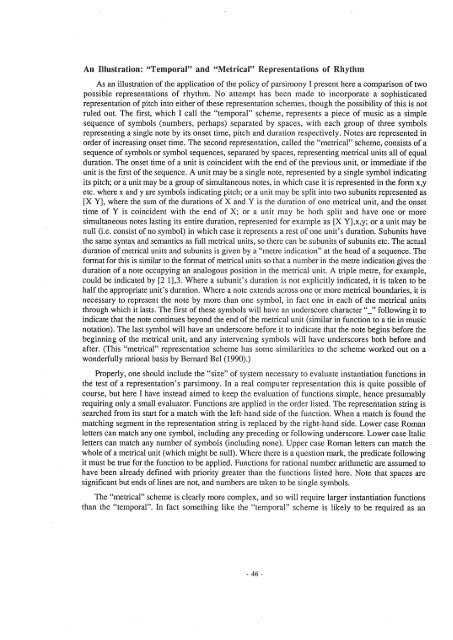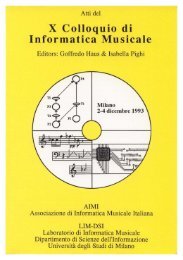Proceedings IX CIM 1991, Genova, November 13-16 - AIMI
Proceedings IX CIM 1991, Genova, November 13-16 - AIMI
Proceedings IX CIM 1991, Genova, November 13-16 - AIMI
You also want an ePaper? Increase the reach of your titles
YUMPU automatically turns print PDFs into web optimized ePapers that Google loves.
An Illustration: "Temporal" and "Metrical" Representations of Rhythm<br />
As an illustration of the application of the policy of parsimony I present here a comparison of two<br />
possible representations of rhythm. No attempt has been made to incorporate a sophisticated<br />
representation of pitch into either of these representation schemes, though the possibility of this is not<br />
ruled out. The first, which I call the "temporal" scheme, represents a piece of music as a simple<br />
sequence of symbols (numbers, perhaps) separated by spaces, with each group of three symbols<br />
representing a single note by its onset time, pitch and duration respectively. Notes are represented in<br />
order of increasing onset time. The second representation, called the "metrical" scheme, consists of a<br />
sequence of symbols or symbol sequences, separated by spaces, representing metrical units all of equal<br />
duration. The onset time of a unit is coincident with the end of the previous unit, or immediate if the<br />
unit is the first of the sequence. A unit may be a single note, represented by a single symbol indicating<br />
its pitch; or a unit may be a group of simultaneous notes, in which case it is represented in the form x,y<br />
etc. where x and yare symbols indicating pitch; or a unit may be split into two subunits represented as<br />
[X Y], where the sum of the durations of X and Y is the duration of one metrical unit, and the onset<br />
time of Y is coincident with the end of X; or a unit may be both split and have one or more<br />
simultaneous notes lasting its entire duration, represented for example as [X Y],x,y; or a unit may be<br />
null (i.e. consist of no symbol) in which case it represents a rest of one unit's duration. Subunits have<br />
the same syntax and semantics as full metrical units, so there can be subunits of subunits etc. The actual<br />
duration of metrical units and subunits is given by a "metre indication" at the head of a sequence. The<br />
format for this is similar to the format ofmetrical units so that a number in the metre indication gives the<br />
duration of a note occupying an analogous position in the metrical unit. A triple metre, for example,<br />
could be indicated by [2 1],3. Where a subunit's duration is not explicitly indicated, it is taken to be<br />
half the appropriate unit's duration. Where a note extends across one or more metrical boundaries, it is<br />
necessary to represent the note by more than one symbol, in fact one in each of the metrical units<br />
through which it lasts. The first of these symbols will have an underscore character "_" following it to<br />
indicate that the note continues beyond the end of the metrical unit (similar in function to a tie in music<br />
notation). The last symbol will have an underscore before it to indicate that the note begins before the<br />
beginning of the metrical unit, and any intervening symbols will have underscores both before and<br />
after. (This "metrical" representation scheme has some similarities to the scheme worked out on a<br />
wonderfully rational basis by Bernard Bel (1990).)<br />
Properly, one should include the "size" of system necessary to evaluate instantiation functions in<br />
the test of a representation's parsimony. In a real computer representation this is quite possible of<br />
course, but here I have instead aimed to keep the evaluation of functions simple, hence presumably<br />
requiring only a small evaluator. Functions are applied in the order listed. The representation string is<br />
searched from its start for a match with the left-hand side of the function. When a match is found the<br />
matching segment in the representation string is replaced by the right-hand side. Lower case Roman<br />
letters can match anyone symbol, including any preceding or following underscore. Lower case Italic<br />
letters can match any number of symbols (including none). Upper case Roman letters can match the<br />
whole of a metrical unit (which might be null). Where there is a question mark, the predicate following<br />
it must be true for the function to be applied. Functions for rational number arithmetic are assumed to<br />
have been already defined with priority greater than the functions listed here. Note that spaces are<br />
significant but ends of lines are not, and numbers are taken to be single symbols.<br />
The "metrical" scheme is clearly more complex, and so will require larger instantiation functions<br />
than the "temporal". In fact something like the "temporal" scheme is likely to be required as an<br />
- 46 -



